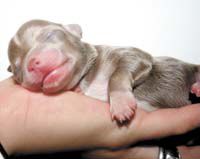| A newborn puppy sleeps three hours after birth. According to animal control experts, the first 24 hours are the most crucial when dealing with newborn pups and they should be treated with the same care as a human baby. |
Getting ready for the arrival of puppies can be exciting for the whole family, however for the adults in the household the potential for still births and some puppies that just don’t make it can make the joyous experience a tense one.
According to veterinarypartner.com one the first things a dog owner needs to note when expecting puppies is the date the dog was bred. After about 35 days of pregnancy the mother’s caloric requirements will begin to increase and she should be allotted approximately twice the amount of food that is normally consumed.
The site warns that owners should be leery of supplementing the dogs diet because it can cause metabolic imbalances. The best nutritional plan it just to increase the amount of dog food specified for growth.
It is recommended that the dog should be seen by a veterinarian on or near the 45th day of pregnancy. At this time the vet will X-ray the dog and let the owner know approximately how many puppies to expect.
Most importantly at home, a comfortable whelping or bedding area should be created for the female dog to birth and nurse the newborn puppies.
“The dog should feel at home here and should be able to come and go as she likes while the puppies remain confined,” said the site. “The gestation period of the dog is considered to be 63 days though this is not written in stone and a normal range might be 58 to 68 days.”
As the birth date approaches, vetrinarypartner.com recommends monitoring the dogs temperature. When the dogs temperature drops below 100 degrees Fahrenheit, labor can be expected within 24 hours.
During the first stage of labor, uterine contractions will begin and the dog will appear very restless and may pace, dig, shiver, pant or even vomit.
According to the site this is all normal and the owners should remain calm and make sure water is available for the dog.
During the second stage of delivery, the puppy is expelled along with the placenta and afterbirth. Puppies are born covered in membranes and the mother will typically bite and lick the membranes away. The site recommends that an individual give the mother a minute or two to do so. However if she does not remove the coating after two minutes the owner should step in and free the puppy from the membrane while rubbing the newborn with a clean towel.
The informational site further recommends that the owner cut the umbilical cord and tie it off one inch away from the puppies body. Puppies will normally come every 45 to 60 minutes but some puppies may not be born for four hours. If it takes more than four hours between puppies, and more are expected the owner should consult a veterinarian.
If the puppies are born to a local family that does not want to keep them officials at the Carbon County Animal Shelter can bring them into the shelter after six weeks with proof that they are indeed a resident of Carbon County.
Morgan Johnson, Animal Control Specialist also noted however that those who would like to take a puppy home instead of bring one in can receive a neutered puppy for $70 and $30 for a dog that has already been spayed or neutered.
“The $30 fee is for the avid chip which is implanted into all dogs at the shelter,” said Johnson. “The chip allows shelter officials to track the information concerning the dog’s owner such as name and address.”
Johnson further recommended that if the dog has a litter of five puppies or more the owner needs to alter the mother’s diet to include puppy food and foods that are high in fat content.
The website cautioned owners that it is normal for the female dog to spike a fever approximately 24 to 48 hours following the birth but the fever should not be accompanied by any clinical signs of illness. Normal discharge from the female should be odorless and may be green, dark red-brown or bloody and may persist in small amounts for up to eight weeks.
For any further information concerning household pets contact the animal shelter at 435.637.6654.

